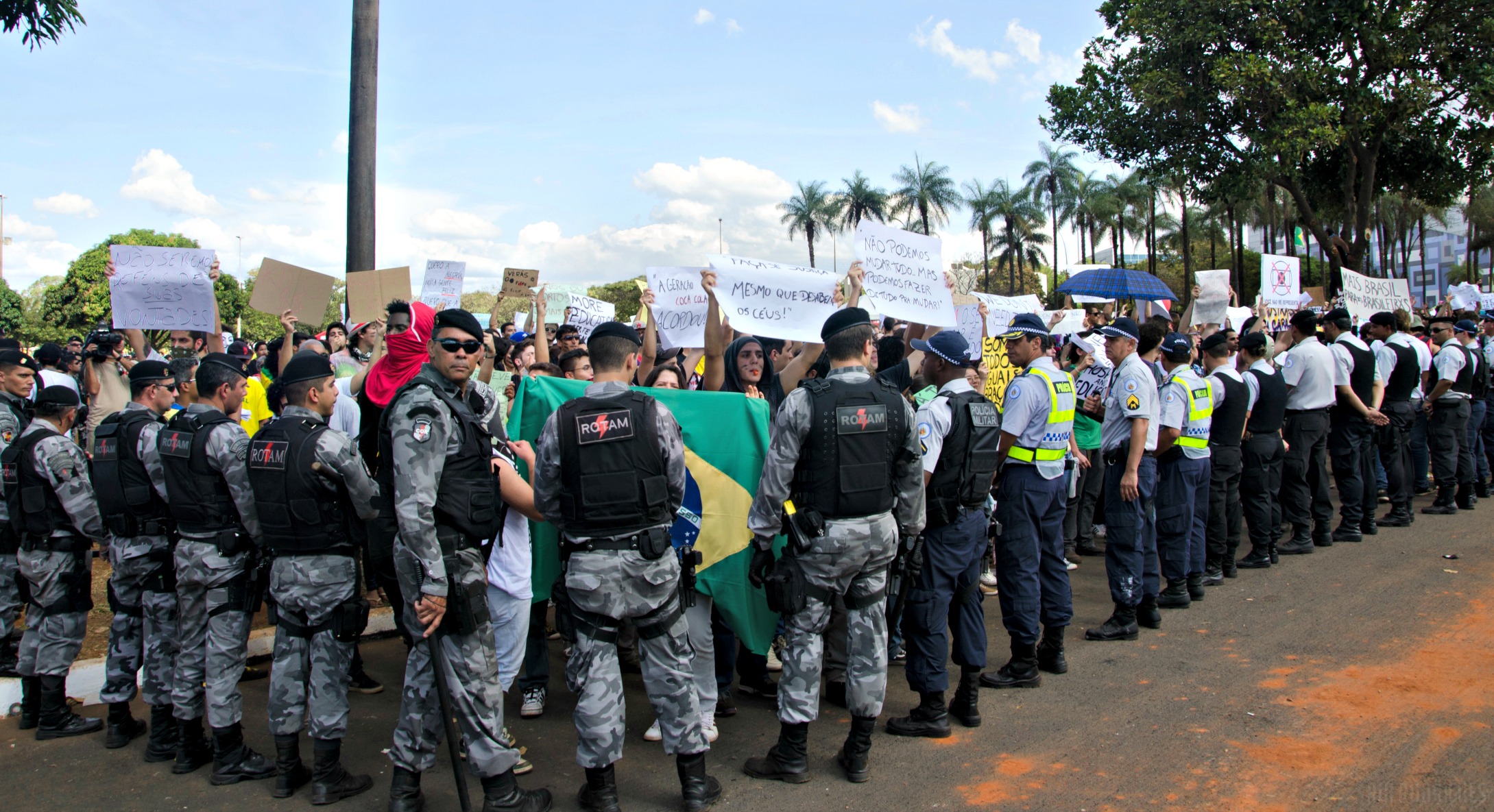 There is an ongoing public debate around the potential negative effects of the mega-events being hosted by Rio de Janeiro. In this post, Jorge de La Barre contributes to this conversation by discussing the mega-event rhetoric in the city and its relation to recent protests in Brazil.
There is an ongoing public debate around the potential negative effects of the mega-events being hosted by Rio de Janeiro. In this post, Jorge de La Barre contributes to this conversation by discussing the mega-event rhetoric in the city and its relation to recent protests in Brazil.
Since at least the 2007 Pan-American Games, Rio’s agenda has been fully predefined by its (sports or otherwise) mega-events. The city finds itself in a strange situation of futuristic emergency, accumulating and combining shocks of order and “future shock” (La Barre, 2015)[1]. The favourite trick for a hegemonic model of urban development, mega-events allow a sort of magic-festive escape, presenting themselves as potential solutions to all of Rio’s structural problems—transport, housing, healthcare, education—even if most of them are in fact as old as the city itself (the “Marvellous city” is celebrating this year its 450th anniversary). In the planners’ excited imagination, mega-events could represent one of the most radical forms of urban “solutionism” (Mozorov, 2013), or the belief that all difficulties have benign solutions, often of a technocratic nature[2]. Yet, as we have seen since the massive protests of June 2013 during the Confederations Cup, there is a crack in the model.
Sign of the current mega-event rhetoric, Rio’s official discourse and vocabulary today is all about challenge and performance: host city, model city, legacy, ranking, etc. At the horizon of Rio’s “Post-2016”[3], we have the promise of a “more integrated and competitive Rio”. Thanks to the miracles of the creative economy, Rio de Janeiro is now betting on “priority sectors”: “fashion, design, audio-visual and tourism” and should soon become Brazil’s “capital of the creative industry”[4]. In fact, Brazil already has its brand, called RJ. Symbol of Rio’s boundless creativity, it is also meant to become “Brazil’s trademark”, combining the aesthetic and humanistic values of Passion, Joy, Beauty, Style, Innovation, Peace, Energy and, last but not least, Pride. In order to sell the RJ brand, and (who knows?) Rio itself to global capital, one needs not be an expert in city-marketing to understand how attractive indeed these “values” are—magically recycled as they get, as festive-contagious sales arguments for the highly competitive global market of creative cities.

Highly festive, sports mega-events come in handy to sustain this global rhetoric of hyper-visibility. In theory they should help “cooling the mark out” (Goffman, 1952). Yet, because of the elitization of football itself (Gaffney, 2014), exactly the opposite happened during the 2013 Confederations Cup and (although in a more brutally repressed form) the 2014 World Cup. Officially celebratory as it should be, the 2014 World Cup held inside and outside the stadiums a massive force of dissuasion against its silenced discontents: thousands of civil and military police around the streets of Rio and all the host-cities, in order to ensure a supposedly threatened public order.
With the UPP (Pacifying Police Units) troops, the attempt to pacify/domesticate Rio’s favelas has accompanied Rio’s mega-events agenda since 2009. Swamped with its inevitable casualties, pacification has come with mixed results to say the least (see for example Karim, 2014). What those in power did not expect is that “the problems” would come from the “official city”—less so from the favela hills—in the form of a radical critique of a city made for global VIP partying. Subjecting such city to heavy police repression in the service of mega-events, in a will to transform public space into a hegemonic global ad-space, and the total absence of any social counterpart, was already creating the conditions for unrest. One of the most urgent claims of the “Vinegar Revolts” (Ansell, 2013) dealt precisely with questions of the right to the city: mobility and housing.
In March 2015 some of the protests called for the military and demanded the impeachment of recently re-elected President Dilma Rousseff,showing Brazil under a very different face: “older, whiter, and richer” (Watts, 2015). In an attempt to avoid possible acts of “vandalism” during the protests (most of them precisely against mega-events), a proposal to lower the minimum age of criminal responsibility is currently in discussion in the Brazilian Congress[5]. Opposing the festive vigilance of the city for mega-events is just not an option. Meanwhile, the Marvellous city is feverishly waiting for its 2016 Olympics. Addressing its structural problems may take a little longer.
Notes
[1] From 2007 to 2016 we will have had in Rio de Janeiro: the 2007 Pan-American Games, the 2010 FifaFanFest, the 2011 Rock in Rio, the 2012 Rio+20, the 2013 World Youth Day and the Confederations Cup (also the year when the Rio’s Art Museum, MAR, opened), the 2014 World Cup, and the 2016 Olympic Games (also the year when Rio’s Museum of Tomorrow will be opening).
[2] See also Ian Tucker, “Evgeny Mozorov: ‘We are abandoning all the checks and balances’”, The Guardian, March 9, 2013.
[3] See Plano Estratégico da Prefeitura do Rio de Janeiro 2009-2012 (2007). Pós-2016. O Rio mais integrado e competitivo, and Plano Estratégico da Prefeitura do Rio de Janeiro 2013-2016 (2011). Pós-2016. O Rio mais integrado e competitivo.
[4] See IPP Rio (2011). Rio integrado e competitivo. Prefeitura do Rio, Instituto Pereira Passos, Diretoria de Desenvolvimento Econômico Estratégico.
[5] See Conectas Human Rights Reveals Brazil’s Attempt to Lower Age of Criminal Responsibility.
References
Ansell, A. (2013). The Vinegar Revolts and the Diverse Faces of Democracy in Brazil, Cultural Anthropology Online, December 20, 2013.
Gaffney, C. (2014). Global Parties, Galactic Hangovers: Brazil’s Mega Event Dystopia. The Los Angeles Review of Books, Oct. 1, 2014.
Goffman, E. (1952). On Cooling the Mark Out: Some Aspects of Adaptation to Failure. Journal for the Study of Interpersonal Processes, 4: 451-463.
Karim, S. (2014). Security or Counterinsurgency in Rio favelas. Americas Quarterly, Apr. 16, 2014.
La Barre, J. de (2015). Future shock: Mega-Events in Rio de Janeiro. Leisure Studies, Routledge: Taylor & Francis.
Mozorov, E. (2013). To Save Everything, Click Here. The Folly of Technological Solutionism. New York: PublicAffairs.
Watts, J. (2015). Brazil: hundreds of thousands of protesters call for Rousseff impeachment. The Guardian, March 15, 2015.
Featured image credit: Leung Man Chan (CC BY-NC-SA 2.0).
About the Author
Jorge de La Barre is an Associate Professor from the Department of Sociology and Methodology of Social Sciences, at Universidade Federal Fluminense (Niterói, Rio de Janeiro, Brazil).
The views expressed on this post belong solely to the author and should not be taken as the opinion of the Favelas@LSE Blog nor of the LSE.
Please read our comments policy before commenting.




